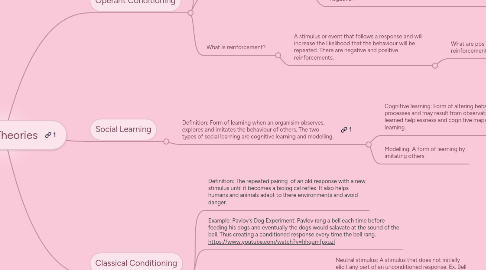
1. Operant Conditioning
1.1. Definition: A form of learning when a certain action or behavior is reinforced with a reward or discouraged with a punishment . This results in an increase or decrease in occurrence. Ex. Positive conditioning: A child does there homework to receive praise from their teacher. Ex. Negative conditioning: A child does there homework so the teacher will not punish them again.
1.2. How is operant conditioning different from classical conditioning?
1.2.1. In classical conditioning the experiment presents the conditioned stimulus and unconditioned stimulus independent of the participants behaviour. Reactions to the conditioned stimulus are then observed. However, operant conditioning is affected by its consequences which can be positive or negative.
1.3. What is reinforcement?
1.3.1. A stimulus or event that follows a response and will increase the likelihood that the behaviour will be repeated. There are negative and positive reinforcements.
1.3.1.1. What are positive and negative reinforcements?
1.3.1.1.1. Positive Reinforcement: A stimulus that increases the chance that a response will occur again. Usually there is a reward.Ex. money, social approval or extra.privileges.
1.3.1.1.2. Negative Reinforcement: Stimuli tend to involve discomfort physically and/or mentally.Behaviors are negatively reinforced when they allow you to escape. One way to think of negative reinforcement is to think of it as something being subtracted from the situation in your favour.
2. Social Learning
2.1. Definition: Form of learning when an organisim observes, explores and imitates the behaviour of others. The two types of social learning are cognitive learning and modelling.
2.1.1. Cognitive learning: Form of altering behaviour that involves mental processes and may result from observation or imitation. Latent learning, learned helplessness and cognitive maps are examples of cognitive learning.
2.1.1.1. What is a cognitive map?
2.1.1.1.1. A cognitive map is a mental picture of a place, spatial relationship of relationships between events. Ex. When the rats developed a cognitive map of the maze and knew the quickest shortcut.
2.1.2. Modelling: A form of learning by imitating others
3. Classical Conditioning
3.1. Definition: The repeated pairing of an old response with a new stimulus until it becomes a biological reflex. It also helps humans and animals adapt to there environments and avoid danger.
3.2. Example: Pavlov's Dog Experiment. Pavlov rang a bell each time before feeding his dogs and eventually the dogs would salavate at the sound of the bell. Thus creating a conditioned response every time the bell rang. https://www.youtube.com/watch?v=hhqumfpxuzI
3.3. What makes up Classical Conditioning?
3.3.1. Neutral stimulus: A stimulus that does not initially elicit any part of an unconditioned response. Ex. Bell ringing
3.3.2. Unconditioned response: An organism's automatic/natural reaction to a stimulus. In other words a reflex. Ex. The salivation of the dog from the meat.
3.3.2.1. Conditioned response: Is the learned reaction to a conditioned stimulus. Not a something you were born with.
3.3.3. Unconditioned stimulus: An event that elicits a certain predictable response without previous training. Ex. Food would normally cause salivation without any training.
3.3.3.1. Conditioned stimulus: A once-neutral event that elicits a given response after a period of training in which it has been paired with (occurred just before) an unconditioned stimulus. Ex. The dog had to be conditioned to associate this sound with food.
